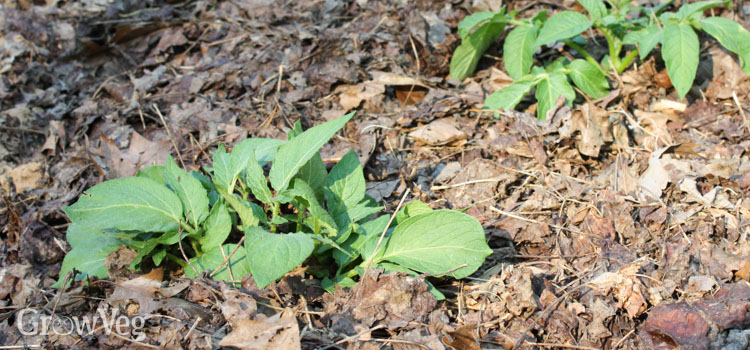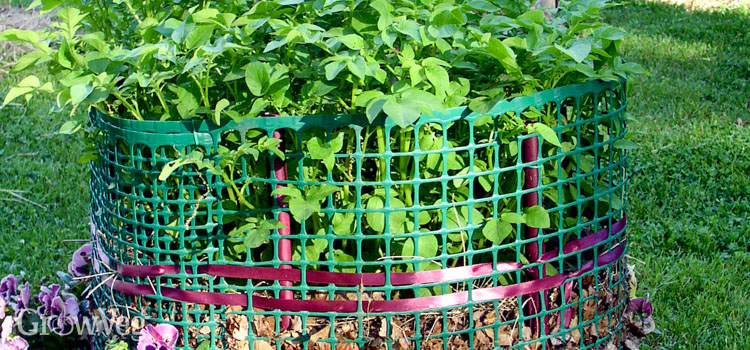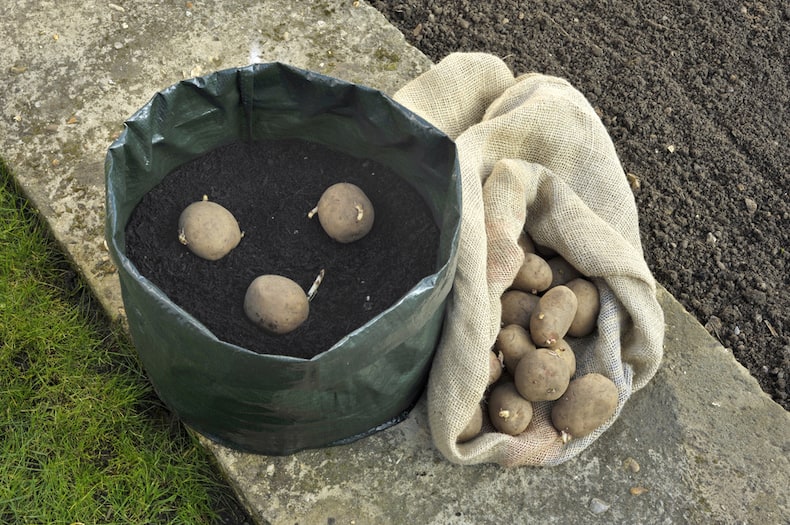Potatoes are a versatile and delicious crop for home gardens. Many gardeners opt to grow spuds in bags or containers rather than directly in the ground. This method allows placement on patios and balconies and makes for easy harvesting. However container-grown potatoes can encounter problems.
Read on to learn the most common pitfalls of growing potatoes in bags and how to prevent setbacks. With a few simple tricks, you can ensure a bountiful bagged potato harvest.
Overheating
Potatoes growing in dark-colored bags or containers in the full sun are prone to overheating, which can stunt plants. The soil temperature inside the bags can get overly hot, preventing tubers from swelling.
Prevention:
- Paint bags white or another light color to reflect heat
- Place containers in partly shaded spots to protect from intense sun.
- Mulch bag tops with straw to maintain cooler soil.
- Ensure adequate moisture – drought stress worsens heat damage.
Poor Drainage
With no way for excess moisture to drain away, soggy conditions quickly develop in bagged potatoes. Wet soil leads to rotting seeds and tubers, fungal issues, poor growth and small yields.
Prevention:
- Use containers with ample drainage holes and add extra if needed.
- Include gravel, sand or perlite in potting mix to improve drainage.
- Avoid overwatering – allow soil to partially dry between waterings.
- Cover bags when heavy rains are forecast to limit excess moisture.
Nutrient Deficiencies
While containers provide a space-saving way to grow potatoes, their confined soil volume can’t hold nutrients to sustain plants through the entire growing season. Deficiencies result in yellowed, stunted foliage and low yields.
Prevention:
- Use a quality potting mix enriched with compost and organic fertilizer.
- Apply a balanced liquid fertilizer every 2-3 weeks during growth.
- Top dress bags with compost or manure midseason to replenish nutrients.
- Mix in a slow-release organic granular fertilizer prior to planting.
Uneven Watering
It’s difficult to thoroughly saturate the entire soil mass in potato bags as plants grow. Dry pockets within the container can stunt tuber development on part of the plant. Inconsistent moisture also causes growth cracks and knobby potatoes.
Prevention:
- Use soaker hoses wrapped around containers to evenly hydrate soil.
- Insert a moisture probe and water when the bottom of the bag becomes dry.
- Carefully dump out bags and thoroughly soak entire soil mass weekly.
Overcrowding
It’s tempting to cram as many potato seeds into a bag as possible. But overcrowded containers lead to excessive competition for water, nutrients and light. Plants bolt or get leggy as they reach for sunlight, and yields suffer.
Prevention:
- Follow seed spacing recommendations, allowing each plant room to spread.
- Use larger containers or limit number of seed potatoes accordingly.
- Once sprouts emerge, snip all but the shortest, stockiest stem on each seed.
Prevention Is Key
Growing potatoes in bags comes with some inherent challenges. But with smart preparation and care, you can produce a bountiful container crop. Select varieties suited to containers, use light-colored bags, ensure drainage, fertilize consistently, and avoid overcrowding plants. With a little diligence, your potato bags will reward you with an abundant harvest!
How to Mulch Potatoes
Any biodegradable mulch is a good mulch for potatoes, though once-popular straw can be a problem because of price and pesticide contamination. I use both grass clippings and weathered leaves since that is what I have, and I especially like the way leaf mulch keeps the potatoes’ root zones cool, moist and free of weeds. A recent research project from Rutgers University showed that plants produced prettier, more uniform tubers with leaf mulch, and it’s fine to combine materials when mulching potatoes, for example by layering leaves with grass clippings. The important thing is to keep a light-blocking blanket of organic material between the shallowest tubers and the sun.

When the plants are ankle-high and need a second round of weeding is the best time to start mulching potatoes. Cut out weeds with a sharp hoe, and then pile up loose soil around the plants so that an extra two inches of soil fits around the crown of each plant. Then start layering on the mulch, and keep adding more until the plants begin to fail.
Now you can dig around under the mulch for some soft new potatoes and start picking all the potatoes from your plants that are very far along. As I pull out each plant, I often move the mulch to the middles of nearby plants that are still growing and need as much mulch as I can get.
When it comes to growing potatoes, the simplest method is the best.
The Problem With Growing Potatoes in Containers
Indeed, researchers in tropical climates have found that when soil temperatures rise above 75°F (25°C), potato plants signal their roots to stop making tubers. Instead, the plants may rev up other reproductive strategies, like developing more fertile flowers, or popping out little green potato-like organs on the main stem. Daytime heating of roots is one reason why potatoes grown in above-ground containers may fail in warm summer climates. Potatoes can take warm air temperatures, but when the roots warm up too, productivity plummets.
Putting potatoes in towers, pots, or bags is also bad because the containers make the plants look smaller. The plants think they are getting close to each other, so they make many small tubers instead of a few big ones. Large containers or broad bins can help with this a little, but think about this: The Master Gardeners of San Francisco, CA (a potato-friendly climate), compared how productive “Carola” potatoes were grown in beds, bins, bags, and pots. Here are the results from the final weigh-in:
| Growing Method | Average Yield Per Plant |
| Mulched raised bed | 2.38 lb (about 1 kg) |
| Wire bin | 0.70 lb (0.32 kg) |
| Plastic pot | 0.62 lb (0.28 kg) |
| Potato bag | 0.58 lb (0.26 kg) |
| Burlap bag | 0.25 lb (0.11 kg) |
You can follow this link to see the thoughtful work done by Canadian garden blogger Isis Loran, but spoiler alert she has not found a potato growing method to rival the hill-and-mulch method, which involves simply growing potatoes in the ground, and mounding loose soil and mulch around them each time you weed. “I loved that I could just rake up or hill up more soil & straw as the plants got bigger. It was much easier in my opinion than trying to add soil to the pallet container or rolling up the burlap bags,” Loran writes.

Loran gardens in a cool maritime climate like that of the British Isles, where potatoes tend to prosper no matter how they are grown. Research by the Royal Horticultural Society has found that variety does make a difference when growing potatoes in containers. When 21 different varieties were grown in 40-litre (16-inch diameter) green plastic potato bags, these varieties were the strongest producers: ‘Casablanca’, ‘Golden Nugget’, ‘Sharpe’s Express’, ‘Maris Bard’ and ‘Lady Christi’.
The story is the same in the US. In Wisconsin, potato lovers involved in the Kenosha Potato Project have found that ‘Calrose’ and ‘Charlotte’ tend to produce larger potatoes than other varieties when growth in soft-sided pots or bags.
FAQ
Why can’t I grow potatoes in bags?
If you’re having problems growing potatoes in bags, here are a few things to check: The soil is too dry: Potatoes need moist soil to grow. Water the potatoes regularly, keeping the soil moist but not soggy. The soil is too wet: Potatoes can’t tolerate soggy soil. If the soil is too wet, the potatoes will rot.
Do potatoes grow in bags?
Harvest the potatoes when the plants start to flower. If you’re having problems growing potatoes in bags, here are a few things to check: The soil is too dry: Potatoes need moist soil to grow. Water the potatoes regularly, keeping the soil moist but not soggy. The soil is too wet: Potatoes can’t tolerate soggy soil.
How do you plant potatoes in a grow bag?
Plant Your Potatoes in the Grow Bag Fold down the top edge of the bag to form a 4″ cuff. Fill the bag with the moistened soil mixture until it’s about 4″ deep. Place the seed potatoes on the soil surface, spaced evenly. Cover with another 3″ of soil. 5. “Hill” Your Potato Plants, Covering with More Soil
How do you care for a potato plant in a bag?
Keep layering in this manner until you reach the top of the bag. Once your plants grow through the soil at the top of the bag, cover the base with mulch, which helps retain moisture and protects growing tubers from sunlight. Keep watering and tending to your potato plants until they flower and naturally begin to die back.
- The Ultimate Guide to Growing Strawberries in Raised Beds - August 8, 2025
- No-Dig Garden Beds: The Easiest Way to Grow a Beautiful Garden - August 6, 2025
- How to Protect and Preserve Wood for Raised Garden Beds - August 6, 2025

